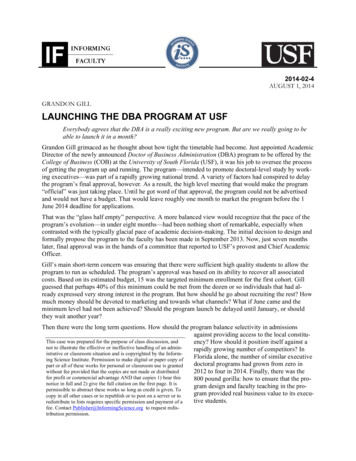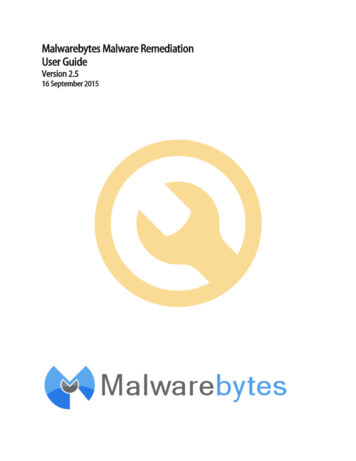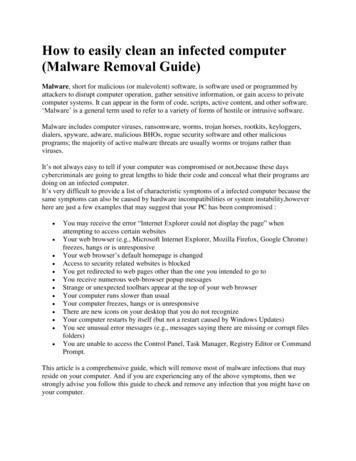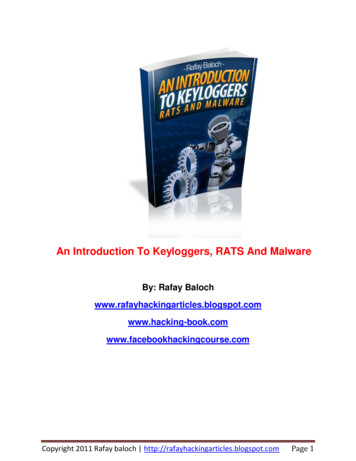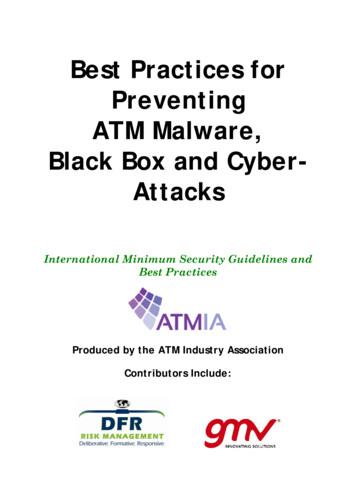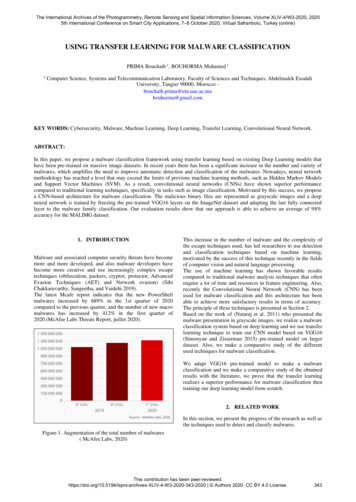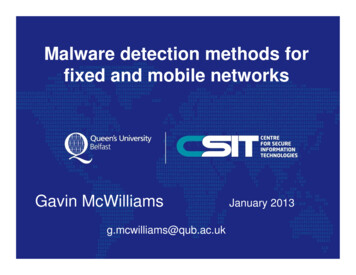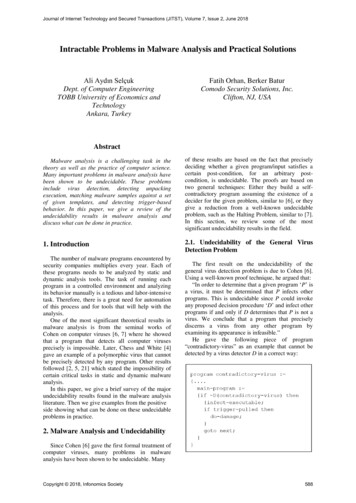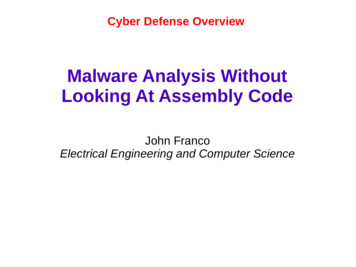
Transcription
Practical Malware AnalysisCh 12: Covert Malware LaunchingLast revised: 4-10-17
Hiding Malware Malware used to be visible in WindowsTask Manager But users often know how to look there So malware authors now try to blend theirmalware into the normal Windowslandscape Covert lanching techniques
Launchers
Purpose of a Launcher Sets itself or another piece of malware For immediate or future covert execution Conceals malicious behavior from the user Usually contain the malware they're loading– An executable or DLL in its own resourcesection Normal items in the resource section– Icons, images, menus, strings– Not considered part of the executable
Encryption or Compression The resource section may be encrypted orcompressed Resource extraction will use APIs like– FindResource– LoadResource– SizeofResource Malware also often contains privilegeescalation code
Process Injection
Process Injection The most popular covert launching technique Two types: DLL Injection and Direct Injection Injects code into a running process Conceals malicious behavior May bypass firewalls and other process-specificsecurity mechanisms Common API calls:– VirtualAllocEx to allocate space in anotherprocess's memory– WriteProcessMemory to write to it
DLL Injection The most commonly used covert launchingtechnique Inject code into a remote process that callsLoadLibrary Forces the DLL to load in the context ofthat process On load, the OS automatically callsDLLMain which contains the maliciouscode
Example Launcher wants Internet access To download more code But a process-specific firewall won't letthe launcher's process access the Internet Solution: inject malicious code intoInternet Explorer process Which already has Internet access
Gaining Privileges Malware code has the same privileges asthe code it is injected into
CreateRemoteThread uses 3parameters– Process handle hProcess– Starting point lpStartAddress(LoadLibrary)– Argument lpParameter Malicious DLL name
Analyzing DLL Injection Once you find DLL injection activity indisassembly Look for strings containing the name ofthe malicious DLL and the victimprocess Or put a breakpoint in the injectioncode and examine the stack to findthem
Direct Injection Injects code directly into the remoteprocess Without using a DLL More flexible than DLL injection Requires a lot of customized code To run without negatively impacting the hostprocess Difficult to write
Process Replacement
Process Replacement Overwrites the memory space of a runningobject with malicious code Disguises malware as a legitimate process Avoids risk of crashing a process withprocess injection Malware gains the privileges of theprocess it replaces Commonly replaces svchost.exe
Suspended State In a suspended state, the process isloaded into memory but the primarythread is suspended– So malware can overwrite its code before itruns This uses the CREATE SUSPENDED value in the dwCreationFlags parameter In a call to the CreateProcess function
ZwUnmapViewOfSection releases allmemory pointed to by a section VirtualAllocEx allocates new memory WriteProcessMemory puts malware in it
SetThreadContext restores the victimprocess's environment and sets the entrypoint ResumeThread runs the malicious code
Hook Injection
Hooks Windows hooks intercept messagesdestined for applications Malicious hooks– Ensure that malicious code will run whenevera particular message is intercepted– Ensure that a DLL will be loaded in a victimprocess's memory space
Local and Remote Hooks Local hooks observe or manipulatemessages destined for an internal process Remote hooks observe or manipulatemessages destined for a remote process(another process on the computer)
High-Level and Low-LevelRemote Hooks High-level remote hooks– Require that the hook procedure is anexported function contained in a DLL– Mapped by the OS into the process space of ahooked thread or all threads Low-level remote hooks– Require that the hook procedure be containedin the process that installed the hook
Keyloggers Using Hooks Keystrokes can be captured by high-levelor low-level hooks using these proceduretypes– WH KEYBOARD– or– WH KEYBOARD LL
Using SetWindowsHookExfor Remote Windows Hooking Parameters– idHook – type of hook to install– lpfn – points to hook procedure– hMod – handle to DLL, or local module, in which thelpfn procedure is defined– dwThreadId– thread to associate the hook with.Zero all threads The hook procedure must call CallNextHookExto pass execution to the next hook procedure sothe system continues to run properly
Thread Targeting Loading into all threads can degrade systemperformance May also trigger an IPS Keyloggers load into all threads, to get allthe keystrokes Other malware targets a single thread Often targets a Windows message that israrely used, such as WH CBT (a computerbased training message)
Explanation of Next Slide Malicious DLL hook.dll is loaded Malicious hook procedure addressMalwareProc obtained The hook procedure calls onlyCallNextHookEx A WH CBT message is sent to a Notepadthread Forces hook.dll to be loaded by Notepad It runs in the Notepad process space
Detours
A Microsoft Product Detours makes it easy for applicationdevelopers to modify applications and theOS Used in malware to add new DLLs toexisting binaries on disk Modifies the PE structure to createa .detour section Containing original PE header with a newimport address table
setdll is the Microsoft tool used to pointthe PE to the new import table There are other ways to add a .detoursection
APC Injection
Asynchronous Procedure Call(APC) Directs a thread to execute other code prior toexecuting its regular path Every thread has a queue of APCs attached to it These are processed when the thread is in analterable state, such as when these functionsare called– WaitForSingleObjectEx– WaitForMultipleObjectsEx– Sleep
Two Forms of APCs Kernel-Mode APC– Generated for the system or a driver User-Mode APC– Generated for an application APC Injection is used in both cases
APC Injection from User Space Uses API function QueueUserAPC Thread must be in an alterable state WaitForSingleObjectEx is the mostcommon call in the Windows API Many threads are usually in the alterablestate
QueueUserAPC Parameters hThread handle to thread pfnAPC defines the function to run dwData parameter for function
1: Opens a handle to the thread 2: QueueUserAPC is called with pfnAPC setto LoadLibraryA (loads a DLL) dwData contains the DLL name (dbnet.dll) Svchost.exe is often targeted for APC injection
APC Injection from Kernel Space Malware drivers and rootkits often want toexecute code in user space This is difficult to do One method is APC injection to get to userspace Most often to svchost.exe Functions used:– KeInitializeApc– KeInsertQueueApc
Practical Malware Analysis Ch 12: Covert Malware Launching Last revised: 4-10-17. Hiding Malware Malware used to be visible in Windows Task Manager But users often know how to look there So

